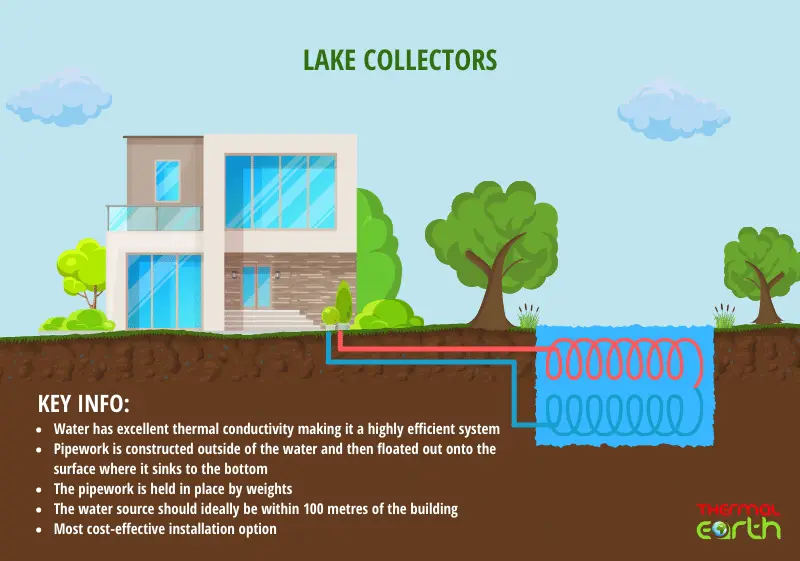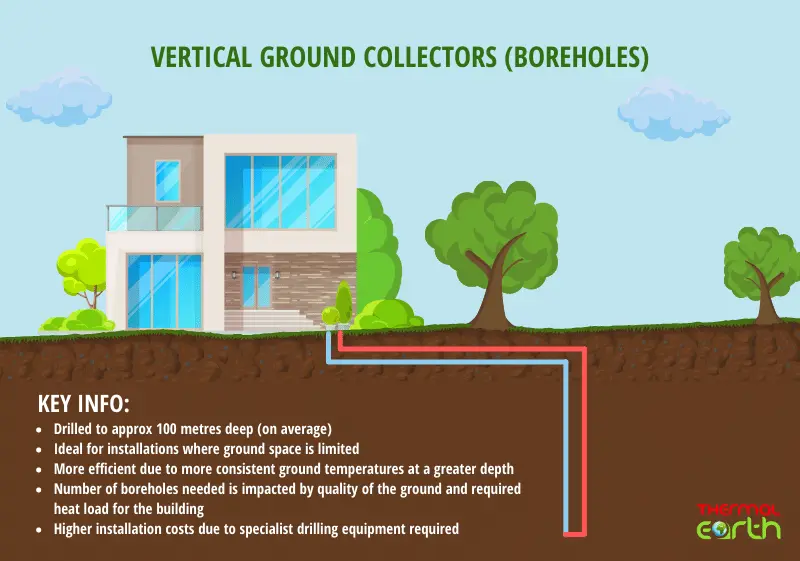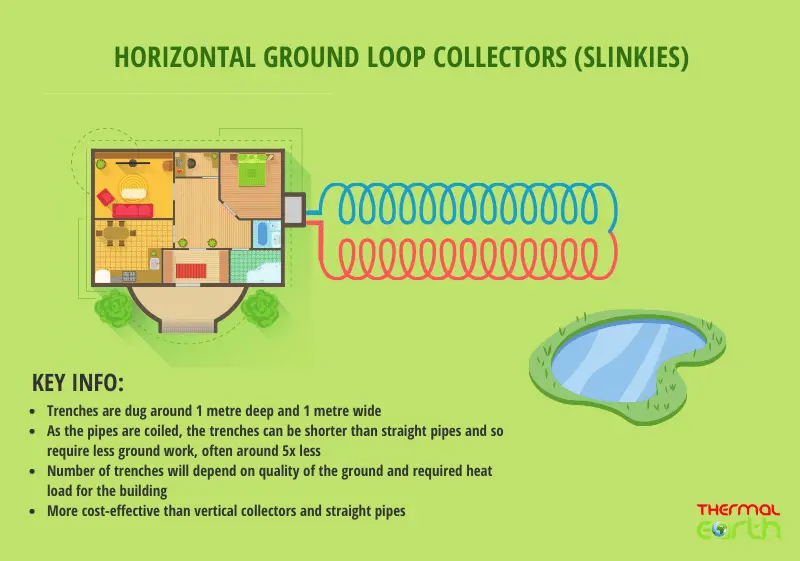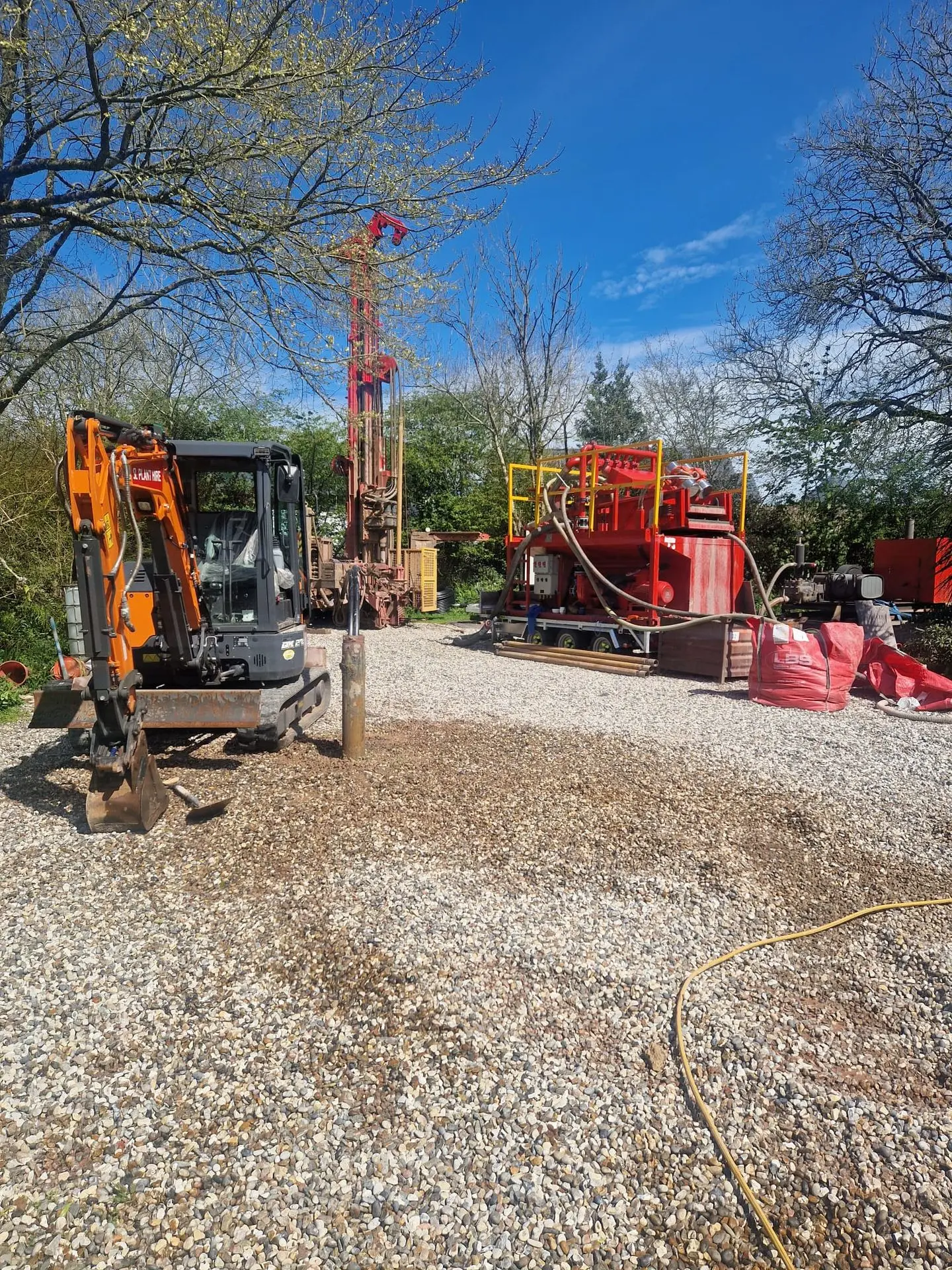WHAT ARE THE DIFFERENT TYPES OF GROUND COLLECTORS FOR A HEAT PUMP?
If you're considering installing a ground source heat pump, you may have already done some research and noticed mentions of ground collectors and wondered what the differences are between them. Below you will find you an explanation of each so that you can develop a clear understanding of the differences to make more informed decisions when it comes to your own heat pump installation project.
What are ground collectors?
The term ground collector or ground arrays, refers to the pipework installed underground which collect and circulate energy from the earth or water to a heat pump. The pipes are filled with a water and refrigerant mixture (often referred to as brine) which conducts the heat energy. When the energy reaches the heat pump, a compressor raises the temperature to a usable level before it is circulated to you heat distribution system to deliver hot water and space heating.
At Thermal Earth we also use heat pumps and the ground collectors to provide:
- Passive and active cooling
- Storage of excess heat energy from Solar Thermal systems
- Although the ground works can take up a large part of the installation budget for a heat pump, ground collector pipe systems have a lifespan of 100+ years, making them an excellent investment for home and business owners.
Which ground collector is right for my project?
This is dependent on several factors including:
- Budget
- Required heat load for the property
- The type of ground surrounding your property
- The amount of space available surrounding your property
- The number of properties or facilities (such as swimming pools) which require heat
- Chosen system and design
At Thermal Earth we carry out site visits and create heat load reports so that we’re able to create an accurate design for your project which takes all of the above factors into consideration.

Lake Collectors and Pond Mats
Ideal For:
Any property including house boats, so long as the water source is large enough to hold the amount of pipework needed to provide the required heat load for the property.
Considerations for using a lake collector or pond mat:
- The water source needs to be deep enough so that it does not freeze in colder weather conditions.
- The minimum recommended depth is 1.2 metres.
- Protecting the system from damage caused by waves, boats, propellers etc
- Pollution of the water from marine fouling
If you have a water source nearby (ideally within 50 metres of the property) then this is always the preferred installation method as water is an excellent thermal conductor (return temperature to the heat pump is around 5-6°C higher than ground source) making the system extra efficient. Water source heat pumps also require very little ground works in comparison to horizontal ground collectors. The only ground work you’ll need is a trench from the water source to your property. This makes lake collectors and pond mats the most cost-effective of all the ground/water collector systems.
The pipework for a lake collector or a pond mat, is constructed outside of the water before being floated out onto the surface where it then sinks to the bottom, held in place by weights or corrosion resistant stainless steel frames.

Vertical Ground Collectors (Boreholes)
Ideal For:
- Housing developments where there is more than one building which requires heating. For projects such as this we can install Shared Ground Arrays where one borehole is capable of producing heat for two or more properties which helps to reduce costs and deliver installations at scale.
- Buildings which have limited ground space.
Vertical ground collectors are installed in one or more boreholes. Drilling boreholes requires specialist drilling equipment which makes vertical ground collectors more costly than horizontal alternatives. The boreholes are drilled down around 100 metres and the pipe system is placed inside, either in loops or as straight pipe.
Boreholes can be drilled as close as you like to your property – it won’t cause any damage but it will get it considerably dirty as the mud and dirt sprays out of the hole during drilling. The borehole itself is only around 20cm wide. Whilst you may not the borehole right next to your property we do recommend having it within 25 metres.
We recommend allowing around 1 week for the drilling of 2 boreholes, this includes the set up and take down of the drilling equipment.
Borehole Pros
- Can fit multiple boreholes with relatively little space
- Arguably the most efficient collector in the ground
- (Thermal Earth advantage only) We have 2x drill rigs in house, you would not be dealing with a sub-contractor
Borehole Cons
- Very, very messy – while drilling straight down might seem less hassle, the mess created needs to be dealt with and can often catch people by surprise with the amount of muddy water ejected from the hole
- Due to the size of the drilling rig, access to some properties can be difficult
- Depending on individual circumstances, is most likely to be the most expensive to install

Horizontal Ground Collectors (Straight Pipe)
Ideal For:
- Properties with a large amount of surrounding land. Popular option for small holdings and agricultural buildings and residences.
Horizontal ground collectors (straight pipe and slinkies), along with boreholes are the most common for heat pump installations in the UK. Straight pipe collectors require a considerable amount of land space (around 100 metres away and 100 metres back from the property. The earth also needs to be of a certain quality and without obstructions such as tree roots. The pipework is placed in trenches, around 1.2 metres deep. Straight pipes have longer and narrower trenches than slinkies.
Pros of Straight Pipe Collectors
- Next to boreholes, this is the next most efficient ground source collector option
- Depending on you having your own builder/digger, this can be the cheapest solution (along with slinky coils)
- Although this solution needs 100m of length, it does reduce the number of trenches required meaning less pipe and a smaller manifold chamber
Cons of Straight Pipe Collectors
- If you do not have any special contacts for a ground worker/machine and have to pay a normal labourer fee, this can often be comparable in cost to boreholes
- It is not enough to just have enough space to accommodate the trenches, you must also have space to put the earth temporarily while the pipes get laid so that they can be re-buried.
- If ground conditions are poor, you will need to pay for a layer of sand to go underneath and on top of the pipe to protect it from sharp stones etc.

Horizontal Ground Loops (Slinkies)
Ideal For:
-
A wide variety of properties with various land/garden sizes and shapes.
Slinkies get their names from their coiled appearance. Like straight pipe collectors they are laid in tenches around 1.2 metres deep. The trenches are wider, but shorter than straight pipe and often require around 5 times less groundwork. The pipe used for slinkies has a smaller diameter, giving it more flexibility to be coiled.
Pros of Slinky Ground Collectors
- Can fit in more types of garden/fields due to the reduction in length vs straight line.
- Pipe is slightly cheaper than straight line due to the diameter reduction.
- Depending on you having your own builder/digger, this can be the cheapest solution (along with straight line collectors)
Cons of Slinky Ground Collectors
- This method is widely regarded as the least efficient. To compensate for the drop in efficiency, more pipe is laid in the ground overall
- If ground conditions are poor, you will need to pay for a layer of sand to go underneath and on top of the pipe to protect it from sharp stones etc
- It is not enough to just have enough space to accommodate the trenches, you must also have space to put the earth temporarily while the pipes get laid so that they can be re-buried
- Unless your ground worker has experience with slinkies, this job is quite physically demanding and will take longer to lay than a straight pipe solution
Want to learn more?
Please get in touch if you would like to learn more about GSHP and how one may be installed in your home.
